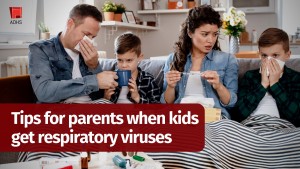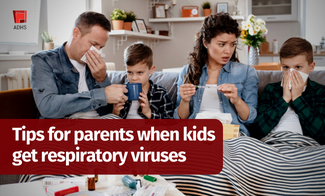 People of all ages get sick with respiratory syncytial virus (RSV), influenza, and COVID-19, but dealing with these diseases can be especially trying for parents of young children.
People of all ages get sick with respiratory syncytial virus (RSV), influenza, and COVID-19, but dealing with these diseases can be especially trying for parents of young children.
Fortunately, in most cases these viruses cause mild illness that can be treated at home by managing fever and pain and drinking lots of clear fluids. In consultation with our partners in pediatrics, we offer the following tips whether your little one’s symptoms are routine or more severe:
What can I do about a stuffy nose?
A cool-mist humidifier or steamy bath may help loosen mucus and phlegm. Since babies and toddlers can’t blow their own noses, a bulb syringe or “snotsucker” can help them breathe and drink or eat more easily. Raising a sleeping child’s head and shoulders a couple inches can help drain mucus, which helps reduce coughing at night.
What can I do if my child has a fever?
First, call your child’s health care provider if a fever is consistently above 102 degrees Fahrenheit and doesn’t respond to medication. Low-grade fevers can be managed safely at home with fever-reducing medications, cool washcloths, and plenty of rest. As for medication, consult a health care provider or pharmacist before giving a child over-the-counter cold, allergy, or sleep medications, as these can have ingredients that aren’t good for kids. Ask a health care provider or pharmacist about dosing instructions for acetaminophen (Tylenol) or ibuprofen (Advil / Motrin), and never give a child aspirin.
When does my child need to see a doctor?
In addition to a high fever that doesn’t respond to medication, seek medical care immediately if a young child has any of the following symptoms:
- inability to take in or hold down liquids
- confusion or difficulty waking up
- bluish lips or face
- symptoms indicating that they are working hard to breathe (trouble breathing or respiratory distress).
Signs of troubled breathing in children can include breathing faster, grunting (a short noise out) with each exhale, flaring their nostrils when inhaling, or pulling in areas above their collarbone, below their ribcage, and/or between their ribs when inhaling. Be aware that children do not have the same energy reserves as adults, so they can tire quickly when working harder to breathe. Do not delay seeking medical attention for any signs of respiratory distress.
If your child has a medical condition that places him or her at greater risk for severe illness, talk with a health care provider beforehand to learn what signs to specifically look for in your child, and where to first seek treatment.
When in doubt, seek medical attention from your health care provider or local urgent care, or call 911.
What else can I do?
Public health basics apply to kids as well as adults. Teach children to wash hands with soap and water for at least 20 seconds, to cover coughs and sneezes, and to avoid touching their faces when possible. At home, clean and disinfect surfaces regularly. Children and adults should stay home if sick. Also, everyone 6 months and older should get a seasonal influenza vaccine and be up to date on COVID-19 vaccination, including the current Omicron booster.
I wish you all a happy and healthy end to 2022 and start to 2023. I hope these tips make this busy time for respiratory viruses a little more manageable for parents.










